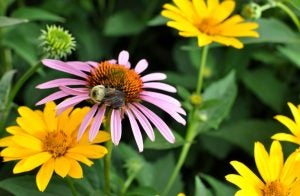It’s that time of year where the days are growing shorter, harvest is underway, and the beauty of the fall season takes over. That also means that many of the flowers that pollinators have depended on as a plentiful food source during the season are starting to fade. Why are pollinators important to those of us involved with growing food?
According to the U.S. Department of Agriculture, approximately 80 percent of all flowering plants on Earth need help with pollination. Pollinators provide the pollination needs to more than 1,400 crops around the world! The diverse pollinator population in the United States alone has a value of $10 billion annually for their pollination efforts on agricultural crops. Globally, pollination services are estimated to be worth more than $3 trillion.
These little critters are really important!
Pollinators definitely still need food supplies through late fall, and you could do your part to help them along by having some late-blooming native perennials in your yard or farm that also make it look nice! Some great choices with late bloom times are asters, goldenrod, and yellow giant hyssop. Long season flowering natives that bloom summer into fall include rattlesnake master, Missouri ironweed, coneflowers, black-eyed Susan, and prairie blazing star.
Check your growing region for the best choices for your USDA zone.

If you want to diversify your garden or yard habitat to coordinate a year-round pollinator friendly space, the Xerces Society has a pollinator list for all areas and regions in the U.S. that include native plants with bloom times, heights, light, and watering needs to guide you in choosing what to add to your garden or farm spaces. Beespotter.org also has a list that has late-flowering plants that are attractive specifically to bees. Finally, for those in the Midwest there is large database that will help you with photos and just about everything else you would want to know about a native plant before you add it!
Related: Are honey bees endangered? Here’s the truth of the matter
Here are some additional tips for a successful fall planting of perennials to help out our pollinator friends:
- Check labels to make sure plants are cold hardy in your zone. Plant them at least six weeks before your zone’s average first frost date so they have time to get established before winter.
- Rehydrate before planting. Soak bare root plants for one hour. Set pots of container grown plants in water for ½ hour or until the root ball is completely wet. Loosen the roots, and then plant at the same level of the soil in your garden (at grade–not high and not too deep.)
- Add compost when planting to help the roots get going, but don’t fertilize until spring.
- Water plants in well, then water only as needed. Stop after the first hard freeze.
- Cover the root area with 3 to 4 inches of mulch, keeping it away from direct contact with stems.
- Mulch helps regulate soil temperature, insulates and prevents winter plant heaving.
To me this sounds like an important thing for all of us to consider doing, even if it is a small “pollinator pocket” in a corner of your yard.
There are great resources from land-grant university extension systems like Illinois Extension and Penn State Extension if you’d like to learn more about pollinators. The HabiTally app can also help track pollinators like monarch butterflies too!
Happy fall planting!
Michelle Miller, the Farm Babe, is a farmer, public speaker and writer who has worked for years with row crops, beef cattle, and sheep. She believes education is key in bridging the gap between farmers and consumers.



